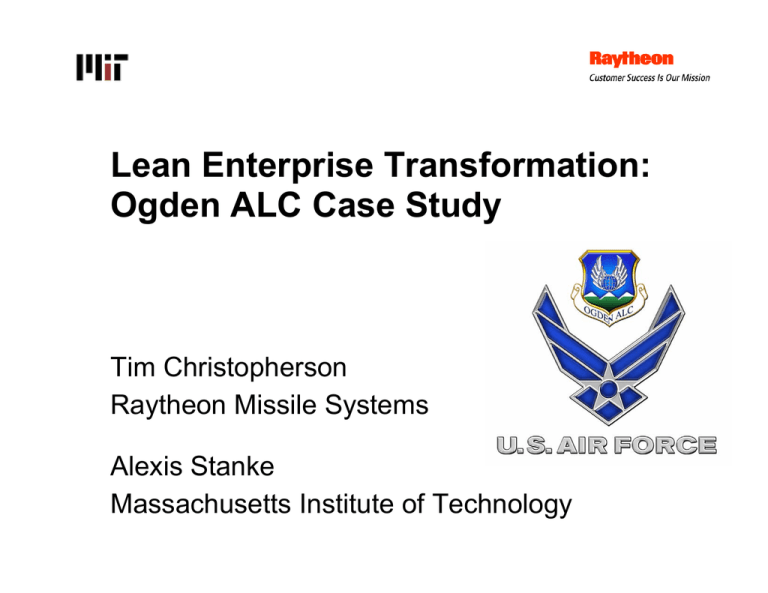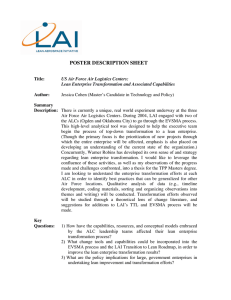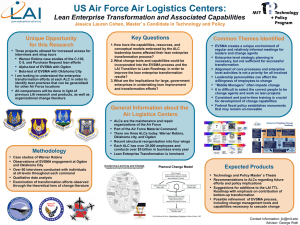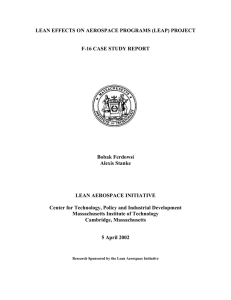Lean Enterprise Transformation: Ogden ALC Case Study Tim Christopherson Raytheon Missile Systems
advertisement

Lean Enterprise Transformation: Ogden ALC Case Study Tim Christopherson Raytheon Missile Systems Alexis Stanke Massachusetts Institute of Technology Overview • Developing a strategy for enterprise transformation • Building capability for managing change • Learning and results A-10 Warthog F-16 Fighting Falcon 3/3/2005 Page 2 Background • Ogden ALC began lean journey in 2002 by Benchmarking, Balanced Scorecard and Activity Based Costing efforts – Initial lean efforts focused on the factory floor – Facilitation provided by consultants • Transformation Office opened on site Aug 2002 – Develop in-house capability to facilitate change • In 2003 lean factory projects expanded and accelerated – Projects above the shop floor begun • Strategic focus was missing Early project in Landing Gear 3/3/2005 Page 3 Lean Aerospace Initiative – Lean Now • Lean Aerospace Initiative (LAI) entered Enterprise Value phase in 2002 – Lean Now projects developed to focus on Air Force value streams F/A 22, Global Hawk, other pilot programs • Ogden and Oklahoma City ALCs develop strategic engagement with LAI in 2003 – Leverage Government-Industry experience in Large-Scale Transformation – Utilize MIT/LAI toolbox Transition To Lean (TTL) Roadmap Lean Enterprise Self Assessment Tool (LESAT) Enterprise Value Stream Mapping and Analysis (EVSMA) 3/3/2005 Page 4 Initial Deployment Schedule Month 1 Month 2-5 Month 3-6 Collect EVSMA 2-4 data Communication Plan ID Black Belt Candidates EVSMA 2-4 Data Review EVSMA 5-6 Current State Review Business Case Analysis Methodology Change Process Defined Benchmarking Change Agent Candidate Selection Process ELT Training (leading change, lean awareness, roles & responsibiliti es) Senior Level Project Reviews (Skip) Maturity Model @ Enterprise Level Long Term Strategic Plan Identify Project Metrics Progress Measurement @ Enterprise Level Knowledge Sharing Approach Conduct Pilot Demonstration OO-ALC Leadership Training Define Enterprise Boundaries ELT Transformation Office LAI Consortium Training Materials Industry Tools/Templates Change Agent Candidate Criteria Create Project Teams (Leads) Project Selection, Prioritization, etc. Methodology Train Black Belt Candidates INPUTS - Prioritized List of Focus Areas EVSMA 7 Visioning Training Methodology (Black Belts, Green Belts, Team) Recognition & Celebration Events Plan to Develop Tool Expertise (SMEs) Project Leadership & Management Training Tool Training for Practitioners Black Belt Candidates Mentoring OUTPUTS - Transformation Office Credibility Continuous Improvement Culture EVSMA Completed with Projects IDÕ d Initial Black Belts IDÕ d and Training Initiated - Long Term Strategic Plan Completed Legend ELT Transformation Office LAI HR Project Teams Change Agent Career Path Conduct Project(s) 3/3/2005 Low Hanging Fruit Captured / Completed Page 5 EVSMA Process (alpha version) • Enterprise Value Stream Mapping and Analysis (EVSMA) piloted at Ogden ALC in 2004 – Process facilitated by MIT, Raytheon, and Boeing 1: EVSMA Set-Up Kick-off 2: Stakeholder Value Exchange 5: Enterprise Interactions 3: Strategic Objectives 6: Current State Synthesis 4: Enterprise Processes 7: Future State Data Collection Source: Massachusetts Institute of Technology Current State Review & Future State Visioning 8: Improvement Plan Implementation Plan Development 3/3/2005 Page 6 EVSMA Set Up (Step 1) • Strategic transformation You are Here effort linked to Center-wide goals • Executive team identified and EVSMA effort chartered • High-level training conducted – Burning Platform – Business Case – Leading Change – Lean Principles – Value Stream Mapping 3/3/2005 Page 7 Stakeholder Value Exchange (Step 2) • Stakeholder perspectives included: End Users Customers Employees Suppliers – Shareholder example below reflects views of Taxpayers and Congress Economical Force Multiplier represents an opportunity from this perspective High Current Performance Compliant Fed Law Local Law Accountability Economic Use Of Funds Viable Force Multiplier for National Security Low Low Relative Importance High 3/3/2005 Page 8 Strategic Objectives (Step 3) • Analysis coincided with development of draft strategic plan for the Center • Intent was to leverage the Balanced Scorecard work done earlier • Center leadership was in transition – New Commander – No Vice Commander – No Executive Director • Result: No significant/meaningful analysis was done at this step • There was a strategic pause on this step 3/3/2005 Page 9 Enterprise Processes (Step 4) • Five enterprise level processes were mapped: – Depot – Supply Chain – Program Mgmt – Readiness – plus Enablers Depot example shows seven primary steps from marketing thru overhaul to ship 3/3/2005 Page 10 Enterprise Interactions (Step 5) • Interrelationships among the five enterprise level processes were mapped – Yarn demonstrates handoffs – Interrelationships assessed using color coded dots Red, yellow, green 3/3/2005 Page 11 Current State Synthesis (Step 6) • Conducted LESAT - scores were low (average 1.6) • Identified sources of waste in the enterprise and opportunities for improvement based on previous steps – Training – Cost reduction – Acquisition process (total) – Getting the right metrics/fewest # needed – Sustainment activities in PM – Schedule effectiveness – Demand planning in SCM – Sustainment feedback to requirements definition – Effective communication Internal & external 3/3/2005 Page 12 Future State (Step 7) Be America’s Best! We will be the Benchmark provider of logistics capability sustaining our Nation’s war fighters. • Support system availability at 90% or better • Support Readiness at 100% • 50% reduction in flow time • 25% cost reduction 3/3/2005 Page 13 Improvement Plan (Step 8) • Seven high-level projects were sponsored focusing on 2-3 year goals determined in Strategic Visioning Exercise – Warfighter Availability Rate = # available aircraft total # planes F-16 aircraft availability A-10 aircraft availability Deployment Process – Stakeholders F-16 Availability Rate Customer Survey – Resources Blackbelt/Greenbelt Plan – Internal Business Processes High Impact Process -0 4 ay M 4 -0 4 Ap r 04 ar -0 M Fe b- -0 3 N ov -0 3 D ec -0 3 Ja n04 -0 3 -0 3 ct O Se p l-0 3 Au g Ju -0 3 n03 Ju 3 -0 3 ay M Ap r 03 ar -0 M Fe b- n03 Training Now Team Ja – Learning and Growth # Unavailable Aircraft Jan ’03 – May ’04 data 3/3/2005 Page 14 Increasing Warfighter Satisfaction • On-going lean events in Depot can’t achieve 90% availability goal – Depot possesses only 1/3 of all unavailable planes – Must work off the shop floor Two-thirds of unavailable aircraft are not in the depot F-16 Unavailable Aircraft Breakdown Maintenance Supply On-going lean events focused on depotpossessed aircraft Ja n0 Fe 3 b0 M 3 ar -0 Ap 3 r-0 M 3 ay -0 Ju 3 n03 Ju l-0 Au 3 gSe 03 p0 O 3 ct -0 N 3 ov D 03 ec -0 Ja 3 n0 Fe 4 b0 M 4 ar -0 Ap 4 r-0 M 4 ay -0 Ju 4 n04 Ju l-0 Au 4 gSe 04 pt '0 O 4 ct -0 N 4 ov -0 4 Depot Jan ’03 – Nov ’04 data 3/3/2005 Page 15 Blackbelt Program • Initial cadre of 11 Blackbelts with plan to grow to 70 within 24 months – 4 weeks of training provided by Raytheon – Blackbelts mentored by Raytheon • Develop self-sufficiency at Ogden within 24 months – Training and Mentoring of Blackbelts by Ogden Blackbelts 3/3/2005 Page 16 Greenbelt Program • Plan to grow from zero to 500 in 24 months – 40hr course adapted from LAI facilitator training Taught by Hill Blackbelts – Topics include: Center Transformation Lean Awareness/Tools Team Dynamics Facilitator Skills/Tools Data Analysis Design Tools Project Management 3/3/2005 Page 17 Continuous Improvement Process Imagine the Future Hold the Gains, Celebrate Achievements, Build for Tomorrow Design & Implement Improvements Visualize Achieve Commit Improve Prioritize Commit to Change Determine Improvement Priorities Characterize Source: Raytheon Define Existing Process/Leverage Points 3/3/2005 Page 18 Business Diagnostic on Supply • Business Diagnostic encompasses first three steps of improvement process – Visualize – Commit – Prioritize Pareto of TNMCS hours PUMP,HYD,ENG DRIVEN RADAR ANTENNA MODULAR LPRF POTENTIOMTR FEEDBCK BRAKE ASSY LEADING EDGE FLP RH VALVE MLG BRKE CONT GEARBOX ACCESS DR HORIZ STABILIZER RADOME ASSY NOSE Top Toptwo twoopportunities opportunities equate equatetoto9-10 9-10aircraft aircraft 3/3/2005 Page 19 Radar Antenna Project • Antenna is repaired in “backshop” at Ogden ALC • Project to focus on reducing TNMCS hrs, leverage previous improvement methods – Characterize End-to-end Value Stream Map (VSM) to be conducted on Antenna – Improve Improvements to focus on constraints from VSM – Achieve Results anticipated by mid-2005 Lean Brake project reduced flow time by 90% 3/3/2005 Page 20 Increasing Warfighter Satisfaction F-16s in Field Maintenance • Opportunity Analyses conducted on Field Maintenance – Focusing on Phase and Fuel System 70% of Phase hours are at Air National Guard (ANG) sites 0341G 300 HR. PHASE 0341H 46000 0 FUEL SYSTEM Pareto100000 of TNMCM Hours 150000 50000 200000 250000 300000 23000 TURBO FAN PWR PLANT 11000 AIRFRAME 03400 PHASED INSPECTION 14A00 45AAA 27Z00 12000 400 HR. PHASE CREW STATION SYSTEM TURBOFAN ENGINE LRU PUMP,HYD,ENG DRIVEN Top Toptwo twoopportunities opportunities equate equatetotonearly nearly40 40 aircraft aircraft PRIM FLT CONT ELECT 3/3/2005 Page 21 Increasing Warfighter Satisfaction F-16s in Depot • Common Configuration Implementation Program (CCIP) impacts significant portion of the F-16 fleet – Prior to Blackbelt program, cellular flow line designed to reduce number of CCIP planes in depot by 10% • Upcoming Structural Augmentation Roadmap (STAR) will require large amounts of depot capacity 1st F-16 CCIP plane completed two weeks ahead of schedule using new pulse cell CCIP line Oct 2004 – Develop lean plan for STAR similar to CCIP Source: Hilltop Times 3/3/2005 Page 22 Lessons Learned • Active learning for executive leadership team through • • • Ja n0 Fe 3 b03 M ar -0 3 Ap r03 M ay -0 3 Ju n03 Ju l-0 Au 3 g0 Se 3 p03 O ct -0 N 3 ov -0 D 3 ec -0 3 Ja n04 Fe b0 M 4 ar -0 4 Ap r04 M ay -0 4 Ju n04 Ju l-0 Au 4 g0 Se 4 p04 O ct -0 4 N ov -0 4 • EVSMA Enterprise transformation requires significant capability to lead and manage change Availability can be improved without additional budget Lean events held exclusively on the shop F-16 Availability Rate floor can’t meet long-term aircraft availability goals Rotation of military leadership creates challenges for continuity # Unavailable Aircraft of alignment on long-term goals Jan ’03 – Nov ’04 data 3/3/2005 Page 23 Further Development • EVSMA process was updated to incorporate lessons learned – More logical order of analysis steps – More focused analysis of pertinent data – Reduced analysis time (from 6+ months down to 3 months) – Deployed at Oklahoma City ALC Tinker AFB F100 engine for F-16 F-35 Joint Strike Fighter (JSF) • Implications for future aircraft – Apply lessons learned on F-16 and A-10 to JSF (and others) Improve aircraft availability rate over future life cycles 3/3/2005 Page 24 Summary • Strategy for enterprise transformation developed and deployed • Capability for managing change initiated • Learning and results summarized 3/3/2005 Page 25






